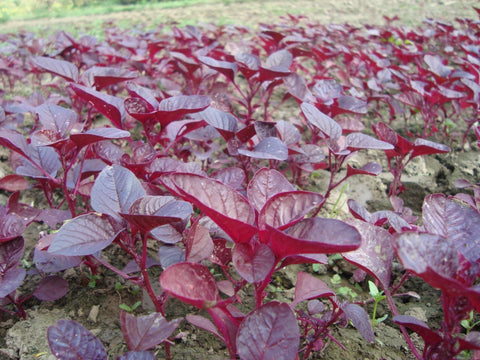20 Surprising Foods That Give You Energy
While many of us are familiar with carbs, proteins, and sugar for spiking energy, surprisingly, it’s the oxygen-boosting foods that give energy. Oxygen supportive foods truly deliver that sustained vigor most of us are looking for, without the regretful sugar crash. The main sources of oxygen boosting in foods come from these three core groups that all boost nitric oxide levels:
- Nitrate - eating nitrate-rich foods boosts nitric oxide and oxygen levels, increasing energy
- L-arginine - L-arginine is a conditionally essential amino acid and is a precursor to nitric oxide
- L-citrulline - metabolizes into L-arginine, and because of this, is also considered a nitric oxide precursor
The benefits of Increasing oxygen levels in the body by eating foods rich in nitrate, L-arginine, and L-citrulline, include:
- Raising energy levels
- Improving strength
- Developing stronger alertness
- Building endurance
- Stimulating brain activity
- Increasing memory capacity
- Boosting concentration
- Reducing stress
- Calming anxiety
- Improving cardiovascular activity
- Strengthening the immune system
Foods that are rich in any of these compounds help drive nitric oxide levels, making our bodies supply more bioavailable oxygen while at the same time decreasing the amount of oxygen our cells actually need to function optimally. Based on this, we’ve curated a list of heavily researched ingredients that boost energy by way of amping up oxygen to every cell in the body.
How do nitrate-rich foods work to give you energy?

Numerous foods contain nitrate, ranging from low to high levels. Studies have shown that nitrate-rich foods enhance sports performance by improving endurance.
Nitrate enters our bodies through the nitrate-rich foods we eat. Once ingested, nitrate is converted to nitrite in a reaction that happens with bacteria in the back of the mouth. This turns to nitric oxide. This nitrate-nitrite-nitric-oxide pathway reduces the oxygen necessary for intense physical exertion increasing exhaustion tolerance - meaning your energy levels stay elevated.
There are many pathways for boosting nitric oxide levels in the body. However, one of the most effective ways is through the food we can eat. Unlike typical neurotransmitters that are produced in advance and stored, the nitric oxide neurotransmitter is produced in greater abundance when needed most. It disperses in all directions affecting many cells, not just the cells where it is made. Nitric oxide controls functions directly related to energy, including metabolism, heat production, oxygen distribution, glucose utilization, and the supply of nutrients to tissue throughout the body.
Ensuring that cells have the nitrite they need to make nitric oxide requires consuming plants rich in nitrate, which is the exact reason we researched this list of specific foods that may send your energy levels soaring.
20 Nitrate-Rich Foods That Give You Energy
#1 Red Spinach
Also known as “Amaranth,” it is not spinach at all but is in the amaranth family of flowering plants, of which quinoa is also a part. Humans have been cultivating amaranth, native to Central America, for at least 6,000 years or more. Ancient cultures utilized amaranth for its anti-aging efforts, and it was revered as a plant that could withstand extreme conditions of heat and wind velocities. As a plant that originated in the Americas, it is still cultivated and eaten through southern, central, and northern America.
Red spinach is packed with nitrate, even more so than beetroot. One study found that the nitrate levels in amaranth enhanced muscle efficiency, fatigue resistance, and performance, providing increased energy levels. The optimal amount to ingest for increased athletic performance is 400 mg, according to the same study. Amaranth has the energy-packed nitrate levels to deliver such high amounts.
#2 Beet Juice
A well-researched, guaranteed energy booster, beets once stood as the top food for nitrate delivery until health researchers discovered the amount of nitrate found in amaranth. Still, beet juice has been documented in numerous studies to improve cardiorespiratory functioning and improve endurance.
#3 Arugula
Originating in the Mediterranean, peppery arugula is packed with nitrate and antioxidants for sustained energy. Arugula’s high fiber, nutrient, and vitamin contents help prevent deficiencies in the body and provide increased energy for more extended periods.
#4 Celery
For a vegetable with such low caloric value, celery is densely packed with nitrate and is definitely one of the foods that give you energy and healing. Studies show that the compounds such as limonene, selinene, furanocoumarin glycosides, flavonoids, Vitamins A and C are why celery is a widely used food for juices and healing soups.
#5 Watercress
Added to sandwiches, soups, and smoothies, the watercress has a high concentration of nitrate. When watercress is chewed, anaerobic bacteria on the tongue use nitrate to produce energy.
#6 Cilantro
Also known to some as coriander, cilantro is loaded with energy-boosting nitrate. Another huge energy-increasing factor of cilantro is its chelation or its heavy metal removal powers. Toxic metals in the system weigh us down and make us feel lethargic. In particular, cilantro is widely popular for its reported ability to enhance mercury excretion in the body, increasing energy levels.
#7 Rhubarb
A prized vegetable in spring and summer, rhubarb also contains high levels of nitrate that boost nitric oxide and this energy. Containing antioxidants, both anthocyanins and proanthocyanidins, rhubarb also helps keep nitric oxide lasting longer in the system by fighting off competing oxidants.
#8 Swiss Chard
The nitrate-rich leafy greens, swiss chard leaves contain some of the highest amounts of Vitamin C, fiber, magnesium, flavonoids, and sodium, and the stems are exceptionally high in potassium. These factors, combined with high nitrate, boost energy and keep blood flow pumping longer.
#9 Kale
Stabilizing blood sugar and containing high levels of nitrate, kale helps keep energy levels sustained. In addition to nitric oxide boosting capabilities, kale contains the amino acid L-tyrosine, which allows the body to conserve energy and manage the body’s use of adrenaline.
#10 Green Spinach
While not in the same category as red spinach (amaranth), green spinach contains healthy quantities of nitrate. According to studies, eating just one cup a day contributes to muscle growth and increased energy levels.
#11 Cabbage
Cabbage is another source of nitrate. As a cruciferous plant, all cabbage varieties are strong heart-healthy foods that give energy and raise levels of many heart-healthy antioxidants like beta-carotene and lutein.
#12 Green Spinach
Green spinach is one of the top choices for dietary nitrate. Although not as nitrate-rich as red spinach, eating raw spinach helps maintain nitrate levels - and by 50% more versus cooked spinach. Research shows, just one cup of green spinach a day can boost muscle function and increase salivary nitrate levels eight times.
#13 Cilantro
Cilantro is a good course of nitrate and helps deliver sustained energy by keeping glucose balanced, preventing sugar-related crashes. Studies show that eating cilantro helps remove heavy metals from the body, which can weigh down energy levels and make us lethargic.
#14 Walnuts
Walnuts are one of the top sources of the nitric-oxide boosting amino acid L-arginine. Walnuts can be easily added to salads or eaten directly as a snack on the go for increasing energy throughout the day.
#15 Almonds
Almonds are one of the best sources of L-arginine. They provide a healthy way of boosting nitric oxide by simply eating a handful a day.. Homemade almond butter is also a great option. It’s the combination of L-arginine and B-vitamin that give almonds the real energy boost.
#16 Watermelon
The power-packed combination of heavy water contents, antioxidants, and amino acids, namely L-citrulline, make watermelon a sports performance superbooster, delivering ample oxygen levels to cells. Watermelon, especially the rind, is one of the best sources of L-citrulline.
#17 Cucumber
Cucumber is another good source of L-citrulline and Vitamin B. While cucumber has less L-citrulline than watermelon, you can consume it in higher quantities in juices without as much sugar intake as watermelon.
#18 Flax Seeds
In addition to being an excellent source of fiber and improving glycemic regulation, flaxseeds also increase nitric oxide by way of L-arginine uptake. Flaxseeds are also confirmed to increase the bioavailability of nitric oxide for the body to use.
#19 Chickpeas
Chickpeas are rich in proteins and contain good levels of the amino acid, L-arginine, adding them to the list of foods that give energy.
#20 Garlic
Garlic is excellent for initiating nitric oxide synthase via the amino acid L-arginine and L-citrulline. Garlic increases nitric oxide levels by up to 40% and increases the ability of absorption by the body. Opt for the raw garlic and allow it to sit for 10 minutes after chopping. This is when Allicin, an organosulfur compound that increases nitric oxide production, is at its peak.
Adding an extra energy boost with antioxidants

While antioxidants aren’t a direct source of energy, they supercharge nitrate foods and protect nitric oxide, helping it last longer in the body, which increases energy levels. Mixing high nitrate foods with antioxidant-rich foods like pomegranate, orange, tart cherries, and berries is smart stacking, the strategic combination of nutrients for maximum benefit. When you’re looking for foods that give you energy, combining high-nitrate vegetables with high antioxidants fruits, berries, and legumes, is a serious energy-boosting stack.
Staying hydrated, getting restful sleep, and eating oxygen-boosting foods from the nitrate, L-arginine, and L-citrulline-rich ingredients listed above, will help with elevating and, more importantly, sustaining high energy levels.
Resources
Jones A. M. (2014). Dietary nitrate supplementation and exercise performance. Sports medicine (Auckland, N.Z.), 44 Suppl 1(Suppl 1), S35–S45. https://doi.org/10.1007/s40279-014-0149-y
Safia Habib, Moinuddin, Asif Ali, 4 - An Overview on Nitric Oxide and Energy Metabolism, Editor(s): Debasis Bagchi, Sustained Energy for Enhanced Human Functions and Activity, Academic Press, 2017, Pages 67-80, ISBN 9780128054130, https://doi.org/10.1016/B978-0-12-805413-0.00004-1
Liubertas, T., Kairaitis, R., Stasiule, L. et al. The influence of amaranth (Amaranthus hypochondriacus) dietary nitrates on the aerobic capacity of physically active young persons. J Int Soc Sports Nutr 17, 37 (2020). https://doi.org/10.1186/s12970-020-00366-5
Domínguez, R., Cuenca, E., Maté-Muñoz, J. L., García-Fernández, P., Serra-Paya, N., Estevan, M. C., Herreros, P. V., & Garnacho-Castaño, M. V. (2017). Effects of Beetroot Juice Supplementation on Cardiorespiratory Endurance in Athletes. A Systematic Review. Nutrients, 9(1), 43. https://doi.org/10.3390/nu9010043
Kooti W, Ali-Akbari S, Asadi-Samani M, Ghadery H, Ashtary-Larky D. A review on medicinal plant of Apium graveolens . Adv Herb Med. 2014;1:48–59. http://eprints.skums.ac.ir/4600/
Norman G Hord, Yaoping Tang, Nathan S Bryan, Food sources of nitrates and nitrites: the physiologic context for potential health benefits, The American Journal of Clinical Nutrition, Volume 90, Issue 1, July 2009, Pages 1–10, https://doi.org/10.3945/ajcn.2008.27131
Wangensteen, H., Samuelsen, A. B., & Malterud, K. E. (2004). Antioxidant activity in extracts from coriander. Food Chemistry. DOI: 10.1016/j.foodchem.2004.01.047
Sears M. E. (2013). Chelation: harnessing and enhancing heavy metal detoxification--a review. TheScientificWorldJournal, 2013, 219840. https://doi.org/10.1155/2013/219840
Young S. N. (2007). L-tyrosine to alleviate the effects of stress?. Journal of psychiatry & neuroscience : JPN, 32(3), 224.
Marc Sim, Lauren C Blekkenhorst, Nicola P Bondonno, Simone Radavelli-Bagatini, Peter Peeling, Catherine P Bondonno, Dianna J Magliano, Jonathan E Shaw, Richard Woodman, Kevin Murray, Joshua R Lewis, Robin M Daly, Jonathan M Hodgson. Dietary Nitrate Intake Is Positively Associated with Muscle Function in Men and Women Independent of Physical Activity Levels. The Journal of Nutrition, 2021; DOI: 10.1093/jn/nxaa415





Comments (0)
There are no comments for this article. Be the first one to leave a message!